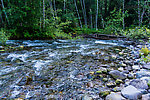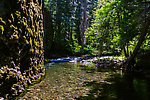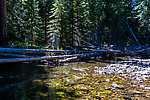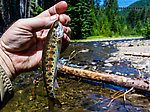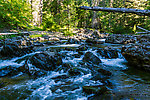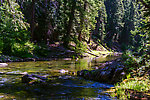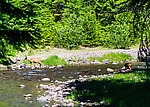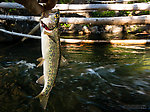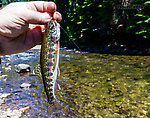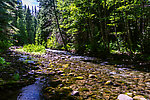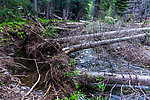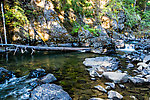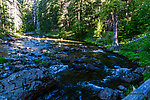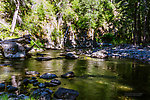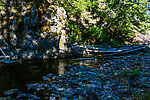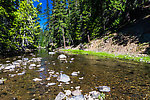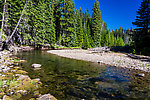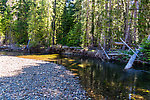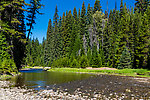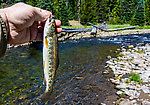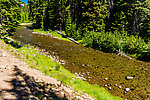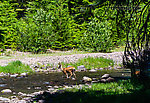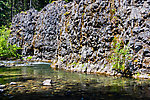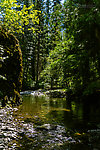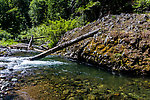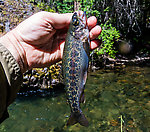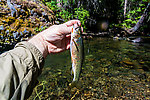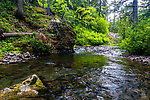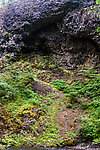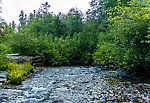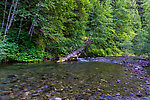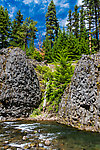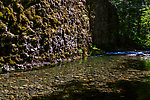Blog & Latest Updates
Fly Fishing Articles
Insects by Common Name


> > A big day on small streams
A big day on small streams
I drove Saturday night to my starting point for Sunday, so I was on the water fishing the Little Naches River as soon as the sun woke me up, around 7:30 am. In these small mountain streams, at this time of year, being up early doesn't seem to do much good. I started out in a canyon reach with some deep, very fish-looking pools, many of which showed no sign of fish. I clamored along the boulders and picked up a couple whopping 6-inchers, then finally a feisty 12-inch rainbow on a nymph, then more fishless pools. When I did find fish here and there, they were mostly on the small size (meaning 6" rather than 8"), and the water felt a bit too big for most of them, like in the forks of the Snoqualmie closer to home.
The character of the stream was charming, though. In covering a lot of ground quickly and peering into crystal clear pools, I was just thinking it reminded me in some ways of fishing New Zealand, where a river like this in the backcountry might hold a 22-inch brown every few pools instead of a 6-inch rainbow. I was just thinking of a grim description of the creek -- "New Zealand fish numbers, Washington fish size" -- when the water exploded beneath my feet. If my chest waders hadn't come with suspenders, I would have jumped right out of them. A fish around 27 inches shot out of a shadow in the calm shallows and into a deeper pool upstream. I didn't get much of a view, but I'm guessing it was a rare summer steelhead. That kept me more alert for the rest of the day.
I didn't see any other big fish, but the warming water boosted the pace of the action. Every pool that looked fishy now had fish, although they were mostly 5-inch rainbows or Chinook parr colliding with each other in their race to my fly. I ate lunch on a perch high above the river, from which I watched a mule deer doe and small buck cross. A little later, a stunning yellow and red Western Tanager flitted among the douglas-firs on the bank. As the creek wound back toward the road, the shrill call of dirtbikes drowned out the sounds of the wild. I eagerly await the invention of virtual-reality games that let them immersively make loud engine noises and even sniff exhaust from the comfort of their living rooms, leaving nature for those who wish to experience it.
After walking a few miles back to my car, I drove some distance to another small stream that proved to be a gem. It ran through a wide (for its size) valley flanked by steep canyon walls, occasionally butting up against the ragged black cliffs and scouring deep pools. The fish were mostly native rainbows, fat and larger than on the Little Naches, and each pool seemed to hold a single large (for its size) Westslope Cutthroat, around 10-12". This one was the star of the trip:
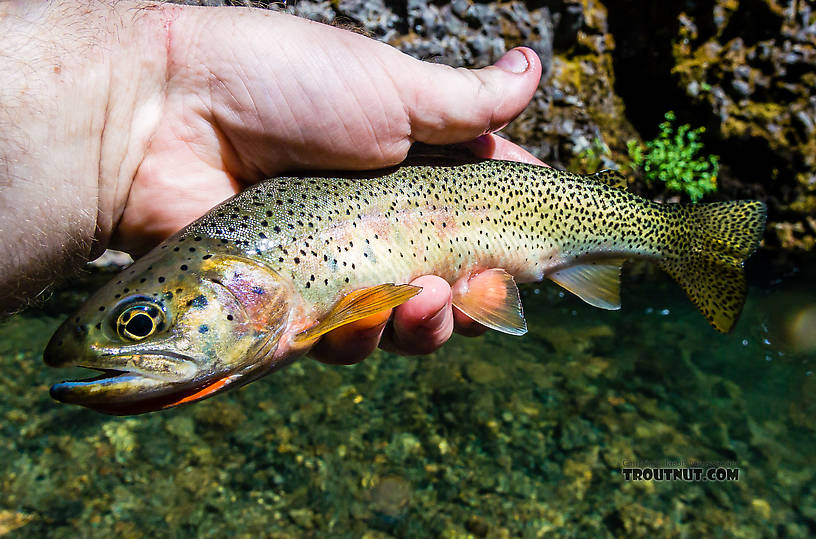
These great pools were fewer and farther between than I would have liked, separated by long stretches of shallow pocket water. Every little pocket held a little trout. Google Earth shows some very hard-to-reach places on this stream with more big pools, so this stream now lingers in my mind with more mystique than most. I'll be back.
On this day, though, I had a long drive home and more fishing to do on the way. Backtracking through the woods out of the mystery creek, I drove back west through Chinook Pass and stopped briefly in the evening at Huckleberry Creek, which flows out of unglaciated highlands on a northern finger of Mount Ranier. I should have guessed that a creek draining the highest mountain around might recover from snowmelt later than the rest, but I didn't. It was crystal clear, but high and cold. Few pools flowed slow enough to hold feeding fish, and in the ones that did, nothing bit.
The character of the stream was charming, though. In covering a lot of ground quickly and peering into crystal clear pools, I was just thinking it reminded me in some ways of fishing New Zealand, where a river like this in the backcountry might hold a 22-inch brown every few pools instead of a 6-inch rainbow. I was just thinking of a grim description of the creek -- "New Zealand fish numbers, Washington fish size" -- when the water exploded beneath my feet. If my chest waders hadn't come with suspenders, I would have jumped right out of them. A fish around 27 inches shot out of a shadow in the calm shallows and into a deeper pool upstream. I didn't get much of a view, but I'm guessing it was a rare summer steelhead. That kept me more alert for the rest of the day.
I didn't see any other big fish, but the warming water boosted the pace of the action. Every pool that looked fishy now had fish, although they were mostly 5-inch rainbows or Chinook parr colliding with each other in their race to my fly. I ate lunch on a perch high above the river, from which I watched a mule deer doe and small buck cross. A little later, a stunning yellow and red Western Tanager flitted among the douglas-firs on the bank. As the creek wound back toward the road, the shrill call of dirtbikes drowned out the sounds of the wild. I eagerly await the invention of virtual-reality games that let them immersively make loud engine noises and even sniff exhaust from the comfort of their living rooms, leaving nature for those who wish to experience it.
After walking a few miles back to my car, I drove some distance to another small stream that proved to be a gem. It ran through a wide (for its size) valley flanked by steep canyon walls, occasionally butting up against the ragged black cliffs and scouring deep pools. The fish were mostly native rainbows, fat and larger than on the Little Naches, and each pool seemed to hold a single large (for its size) Westslope Cutthroat, around 10-12". This one was the star of the trip:

These great pools were fewer and farther between than I would have liked, separated by long stretches of shallow pocket water. Every little pocket held a little trout. Google Earth shows some very hard-to-reach places on this stream with more big pools, so this stream now lingers in my mind with more mystique than most. I'll be back.
On this day, though, I had a long drive home and more fishing to do on the way. Backtracking through the woods out of the mystery creek, I drove back west through Chinook Pass and stopped briefly in the evening at Huckleberry Creek, which flows out of unglaciated highlands on a northern finger of Mount Ranier. I should have guessed that a creek draining the highest mountain around might recover from snowmelt later than the rest, but I didn't. It was crystal clear, but high and cold. Few pools flowed slow enough to hold feeding fish, and in the ones that did, nothing bit.
Photos by Troutnut from Mystery Creek #211, Huckleberry Creek, and the Little Naches River in Washington
On-stream insect photos by Troutnut from the Little Naches River and Mystery Creek #211 in Washington
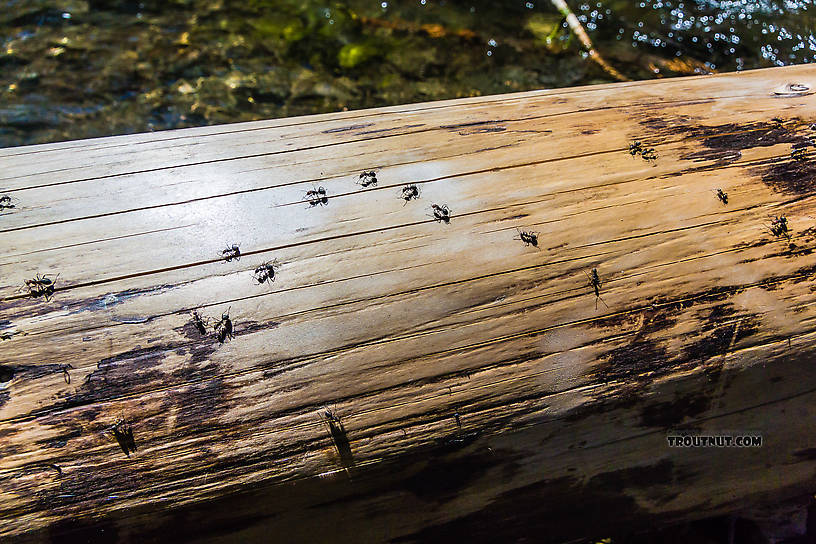
StateWashington
LocationLittle Naches River
Date TakenJul 8, 2018
Date AddedJul 9, 2018
AuthorTroutnut
CameraNIKON 1 AW1
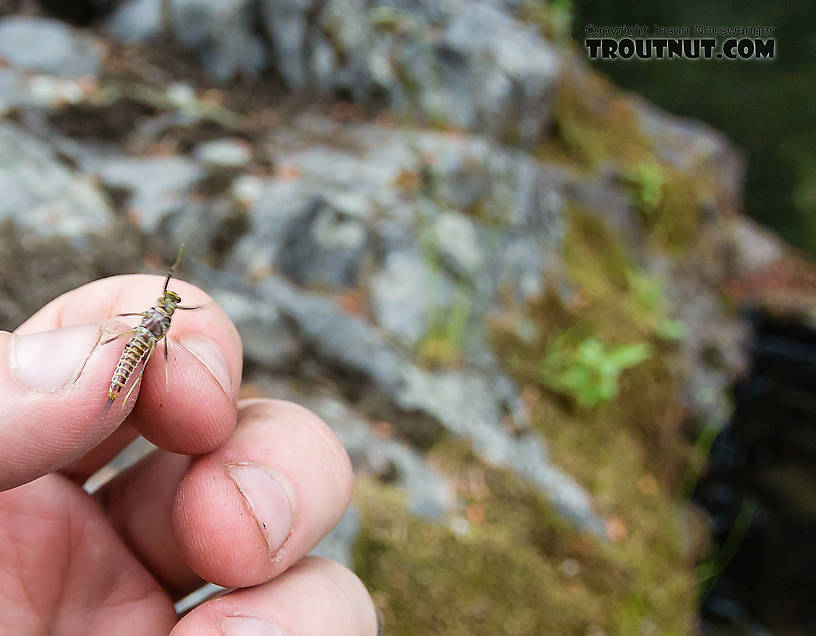
Comments / replies
| Partsman | July 10th, 2018, 3:31 pm | |
| bancroft michigan Posts: 420 | Wow Jason, beautiful pictures! That cutthroat is awesome. Thanks for sharing your trip with us, its almost to hot to fish here in Michigan, I tend to agree with 68 degree pledge, although I may fudge a couple degrees. I have family visiting from out west so no big deal right now, but Im ready to go once everyone has left. Please keep up the reports, as I have been invited out to Oregon, so maybe I may have to prepare for a adventure out that way. Mike. | |
| Martinlf | July 10th, 2018, 6:22 pm | |
Moderator Palmyra PAPosts: 3233 | Gorgeous, Jason. Thanks. | |
| "He spread them a yard and a half. 'And every one that got away is this big.'" --Fred Chappell | ||
| Jmd123 | July 10th, 2018, 7:06 pm | |
| Oscoda, MI Posts: 2611 | Again, beautiful. And wow, those Westslope Cutts! James Prosek drew one in his first book that's extremely colorful like that, and he wasn't exaggerating! And the scenery isn't too shabby either… Jonathon | |
| No matter how big the one you just caught is, there's always a bigger one out there somewhere... | ||
Quick Reply
You have to be logged in to post on the forum. It's this easy:
Troutnut.com is copyright © 2004-2024 Jason
Neuswanger (email Jason). See my FAQ for information about use of my images.
 privacy policy
privacy policy


